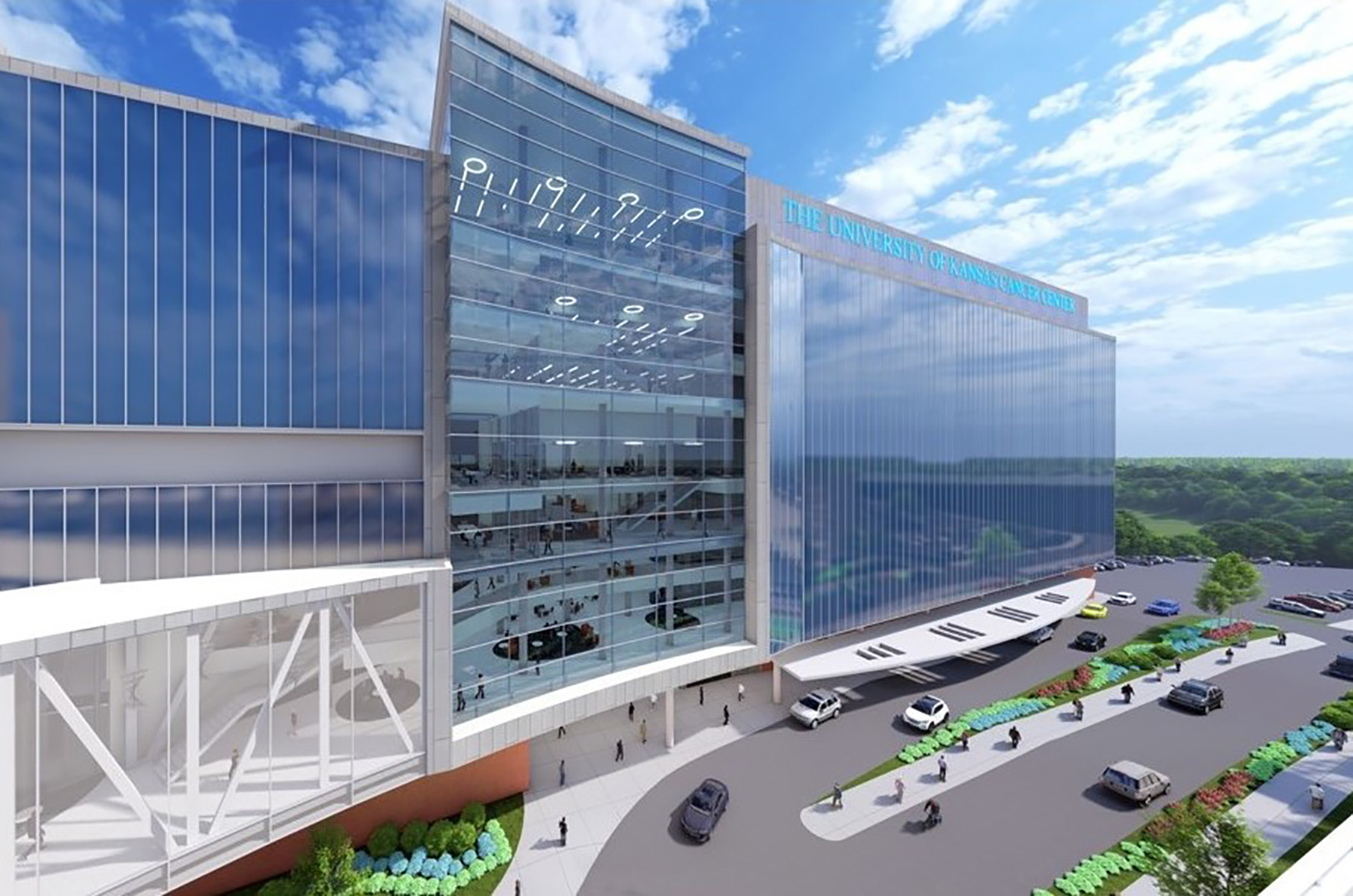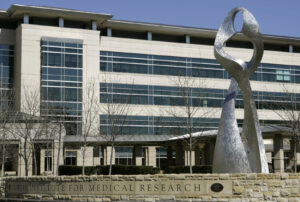Editor’s note: This story was originally published by Kansas City PBS/Flatland, a member of the KC Media Collective, which also includes Startland News, KCUR 89.3, American Public Square, The Kansas City Beacon, and Missouri Business Alert.
Click here to read the original story.
The Children’s Mercy Research Institute stands like a lighthouse overlooking downtown Kansas City, Missouri, with its all-glass façade illuminated at night with strands representing genomic variances found in Children’s Mercy patients.
The wavy nine-story building, modeled on the double helix structure of DNA, cost approximately $200 million and totals about 375,000 square feet. But something even bigger is taking shape just a few miles west.
Much bigger.
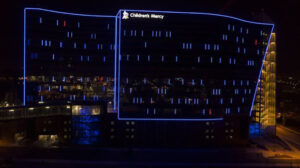
Opened in 2021, the Children’s Mercy Research Institute building glows at night with DNA sequences of Children’s Mercy patients; Contributed photo
If all goes as planned, the University of Kansas Cancer Center will break ground early next year on a complex that could ultimately be twice the size of the Children’s Mercy Research Institute, which opened two years ago.
Designed to bring the cancer center’s clinical and research staff under one roof, the building will be shoehorned onto the northern edge of the Kansas City, Kansas, campus that houses the University of Kansas Hospital and its academic partner, the University of Kansas Medical Center.
Asked if there is anything like the proposed building in the region, KU Cancer Center Director Dr. Roy Jensen said: “Oh no. Not at all. Nothing close.”
But the bigger story is not one of bricks-and-mortar one-upmanship.
The new facilities — which also include a proposed University of Missouri-Kansas City building around the corner from Children’s Mercy — speak more to the decades-long quest to establish Kansas City as a regional life sciences powerhouse.
Part and parcel of that effort is the emergence of the KU Cancer Center as a nationally recognized center of excellence and the accompanying resurrection of KU Hospital as part of the University of Kansas Health System.
Big Win
In July, KU officials and other life sciences leaders joined Jensen in celebrating a huge milestone. The KU cancer center had obtained “comprehensive” status from the National Cancer Institute (NCI), an upper-level designation the cancer center had pursued since earning NCI’s initial stamp of approval a decade before.
The comprehensive status, earned after submitting an application of more than 1,700 pages, placed KU among roughly 50 other elite cancer centers around the nation. It also came with a five-year, $13.8 million research grant.
As part of the deal, the cancer center promised NCI reviewers that it would consolidate a scientific and clinical workforce that is now scattered among a dozen or so buildings on the medical campus at 39th Street and Rainbow Boulevard and elsewhere.
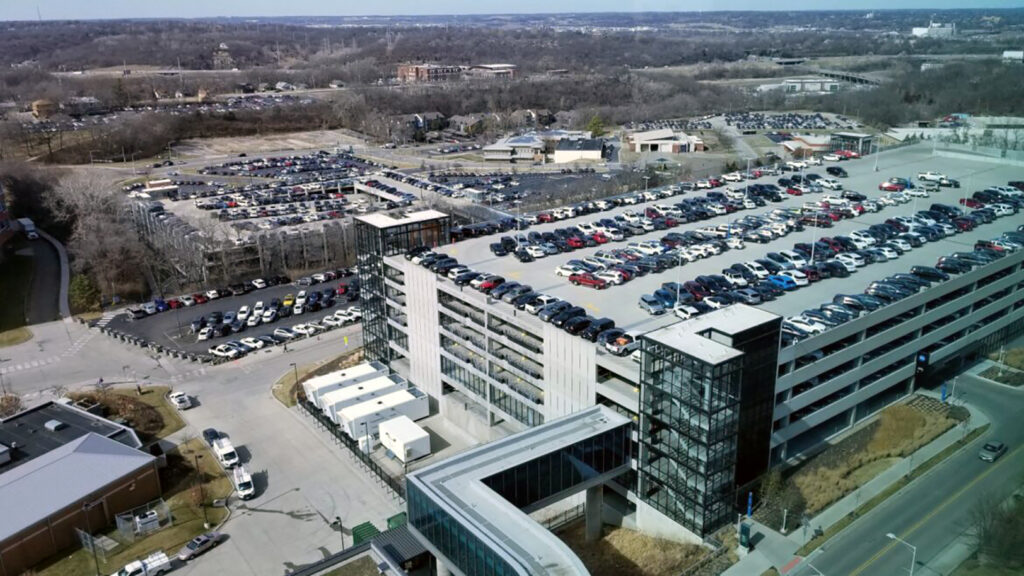
This view, looking northwest, shows the site of the KU Cancer Center’s proposed new building. The plan is to place the building between the two parking structures; Photo by Mike Sherry, Kansas City PBS, Flatland
The intent is to foster the creative brainstorming that comes from impromptu hallway meetings and water-cooler discussions.
The expectation is that the cancer center will complete the first phase of the building by the time NCI reviewers return to campus in 2027 as part of the renewal process for comprehensive status.
Jensen estimated it will cost approximately $450 million to build the initial phase, which could include as much as 500,000 square feet. Even a building that size would nearly rival the medical tower that KU Health System opened in 2017, which takes up a square block around the intersection of 39th Street and State Line Road.
It’s a “transformational event of unparalleled impact. It is the single most important thing that we can do to elevate our program to an extremely prominent position on the national stage.”
— Dr. Roy Jensen, director of the University of Kansas Cancer Center
A federal earmark of $43 million in last year’s omnibus appropriation bill is a “huge step forward” in raising money for the cancer center building, Jensen said. It is unclear when the building will be fully built out. But when it is, Jensen said, the building could be 10 stories high with as much as 750,000 square feet.
Examples like Penn Medicine’s Abramson Cancer Center in Philadelphia prove that consolidating the staff is a “transformational event of unparalleled impact,” Jensen said. “It is the single most important thing that we can do to elevate our program to an extremely prominent position on the national stage.”
One big driver of that effort is ensuring patients around the region have top-notch care close to home, rather than traveling to, say, the MD Anderson Cancer Center in Texas. Another impetus is to help make strides in battling cancers, such as those of the brain and pancreas, that remain difficult to treat.
Roadmap
The new cancer building serves as a milestone along the road that the region has traveled in creating a life sciences hub that, according to some, takes in a vast “animal health corridor” stretching from Kansas State University in Manhattan, Kansas, to the University of Missouri in Columbia, Missouri.
One reading of that journey dates back to 1950, when one of Kansas City’s most famous entrepreneurs and civic leaders, Ewing Kauffman, started Marion Laboratories out of his home at 67th and Locust streets in Kansas City, Missouri. The pharmaceutical company thrived for decades before a series of mergers ended its footprint here in the late 2000s.
Members of Kansas City’s scientific community will tell you that the diaspora of the Marion Laboratories workforce over the years formed the bedrock of a regional life sciences business cluster that, by one estimate, now includes nearly 300 companies and employs approximately 35,000 workers.
Other milestones along the way have included:
- The 1994 founding of the Stowers Institute for Medical Research, which sits on a 10-acre campus just east of the Country Club Plaza. The institute’s researchers focus on basic science aimed at diagnosing, treating and preventing disease.
- The 1999 formation of the nonprofit Kansas City Area Life Sciences Institute, later renamed BioNexus KC, to catalyze economic development around the region’s scientific expertise.
- The 2008 establishment of the Johnson County Education Research Triangle, funded through a voter-approved one-eighth-cent sales tax that directs proceeds to the K-State Olathe campus, the KU Edwards campus in Overland Park, and the KU Clinical Research Center in Fairway, which helps fund clinical trials for the KU Cancer Center. The tax generates about $15 million annually.
Of all the life sciences developments, the turnaround of KU Hospital is one of the most momentous.
Beset by poor customer satisfaction, sour employee morale, and dwindling patient volume, political and education leaders separated the hospital from the state in 1998 so it could operate more nimbly as a public hospital authority.
Twenty-five years later, the hospital is part of a health system that in January continued its growth by absorbing Olathe Health, which includes the 300-bed Olathe Medical Center. The system also spent approximately $61 million five years ago to rehab the former Kansas City, Kansas, offices of the U.S. Environmental Protection Agency into a mental health facility.
The system’s 2019 annual report, the latest available online, reported more than two million patient visits and the provision of nearly $70 million in charity care to Kansas residents.
The hospital also serves as a vital component of the consortium assembled by the KU Cancer Center.
As a local life sciences entrepreneur, Maria Flynn had a front-row seat to the hospital’s transformation when she officed in a KU Med business incubator on the Kansas City, Kansas, campus. She was there from 2008 to 2014.
Gradual improvement does not capture the public imagination like today’s opening of the new Kansas City International Airport or the Chiefs’ Super Bowl win this month, Flynn said. But that does not diminish the impact of the hospital’s resurrection and the role it played in bringing the cancer center to national prominence.
“This is something a lot of people missed,” Flynn said. “We do have something great, and it’s right here.”
Working Together
Kansas Citians have watched business interests repeatedly stir tensions on both sides of the Missouri-Kansas state line that bisects the city. But bi-state collaboration is a hallmark of the regional life sciences ecosystem.
Children’s Mercy, for instance, is a consortium partner with the KU Cancer Center and is also part of the Frontiers Clinical & Translational Science Institute, which focuses on turning scientific discoveries into medical breakthroughs.
Other Missouri side partners in these endeavors include the Stowers Institute and its neighbor, UMKC, which has organized the cluster of health institutions on Hospital Hill into what it calls the Health Sciences District.
It is within that district, at 25th and Charlotte streets, that UMKC plans to construct its new $120 million Healthcare Innovation and Delivery Building on what is now a university parking lot. The university plans to break ground next year on what ultimately could be a seven-story building totaling nearly 200,000 square feet.
In response to email questions, a UMKC spokeswoman said the building will enable the university to provide “leading-edge health care education, attract top students and researchers and advance care for disinvested populations.”
Planned improvements include simulation labs and classrooms for the university’s medical students and state-of-the-art technology that will expand the number of patients its dental students can treat.
Space in the new building will also accommodate the university’s Health Equity Institute, Data Science and Analytics Innovation Center and its new biomedical engineering program, which is expected to launch in the fall.
Like the KU Cancer Center, UMKC views its new building as a hub of collaboration. The biomedical engineering program, for instance, is designed to place doctors and the developers of medical devices within close proximity to accelerate breakthroughs in areas like imaging technology, implants and microsurgery tools.
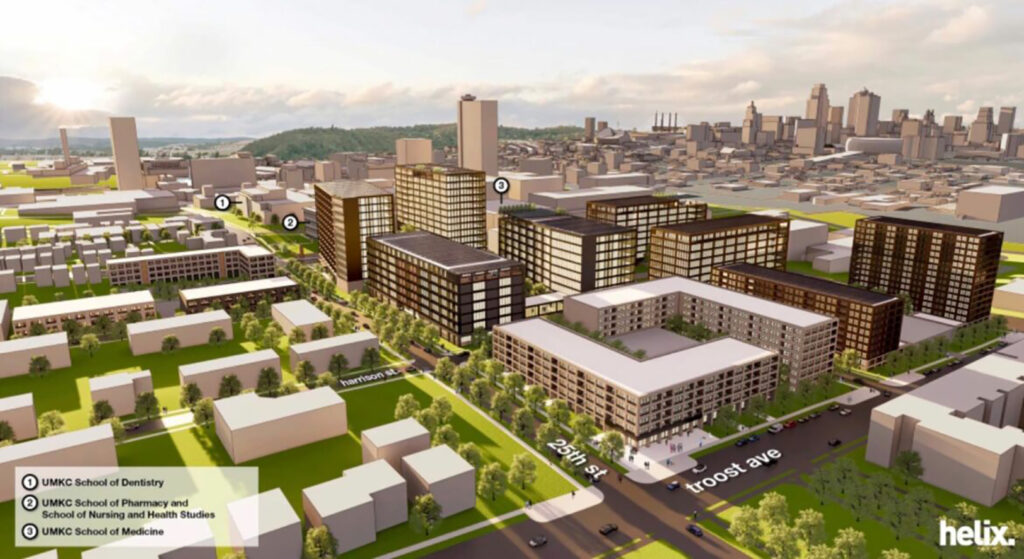
The University of Missouri-Kansas City has plans to add this Healthcare Innovation and Delivery Building to the Health Sciences District on Hospital Hill in Kansas City, Missouri; Rendering by Helix Architecture + Design
Dr. Mario Castro has a bird’s eye view of the forces at work driving the construction and expansion of programs on both sides of the state line — besides the specific example of the cancer center responding to feedback from NCI.
A pulmonologist and KU Med’s vice chair for clinical and translational research, Castro also serves as the director of Frontiers, which brings together eight medical institutions on both sides of the state line.
Some of the growth, he said, has come from the region’s expanding footprint in clinical trials.
One of the most notable examples of those endeavors came more than two years ago when Castro led KU Med’s participation in a COVID-19 treatment trial, which was sponsored by the National Institute of Allergy and Infectious Diseases and spanned at least 40 sites across the nation.
The influx of federal dollars for research and clinical trials in the region predated the pandemic, he said. In the three-plus years Castro has been at KU Med, he said, the amount of National Institutes of Health funding coming to the medical center has increased by 50%.
Program expansion also includes purchasing and housing the latest technology, Castro said. He noted, for instance, a federal appropriation that funded a new $2.5 million CAT scanner for lung cancer screenings and research. That will allow him and his team to do an entire scan of the lungs and the chest in half a second.
That technology was not around even 10 years ago and there are fewer than a dozen of those machines available in the entire country, Castro said. “It really moves us and the region to the cutting edge,” he said.
One example of the regional benefits of advanced technology, he said, is the work his team is doing with specialized imaging around the early development of cystic fibrosis. KU Med is working with Children’s Mercy to provide this advanced MRI scanning to patients from there with cystic fibrosis.
If there’s anything that can slow down the region’s advances in life sciences, Castro said, it will be attracting and retaining enough workers. KU Med, he said, has been “hiring like crazy,” but the competition with industry and other academic medical centers is intense.
Castro’s refrain will be familiar to human resources professionals and anyone else who has contended with outsiders’ view of the city as one spot in the vast expanse of “flyover country” between the coasts.
When talking with potential new hires, he said, “I have to convince someone who is coming from Chicago, from New York, or other regions, that Kansas City is a great place to live, a great place to raise your family, and attracting that talent has been our biggest hurdle.”
Mike Sherry is a former editor and writer for Flatland. He is now a communications consultant for nonprofits and freelance writer.




